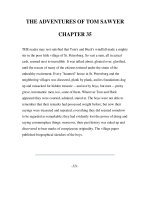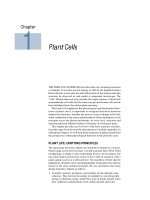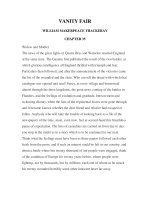Chapter 35 plant phy IU
Bạn đang xem bản rút gọn của tài liệu. Xem và tải ngay bản đầy đủ của tài liệu tại đây (9.97 MB, 66 trang )
UNIT 6
PLANT FORM AND FUNCTION
Interview: JOANNE CHORY
Chapter 35: PLANT STRUCTURE AND GROWTH
Chapter 36: TRANSPORT IN PLANTS
Chapter 37: PLANT NUTRITION
Chapter 38: PLANT REPRODUCTION AND BIOTECHNOLOGY
Chapter 39: PLANT RESPONSES TO INTERNAL AND EXTERNAL SIGNALS
Chapter 35
PLANT STRUCTURE AND GROWTH
1. THE PLANT BODY
- Both genes and environment affect plant structure
- Plants have three basic organs: roots, stems, and leaves
- Plant organs are composed of three tissue systems: dermal, vascular, and ground
- Plant tissues are composed of three basic cell types: parenchyma, collenchyma, and sclerenchyma
2. THE PROCESS OF PLANT GROWTH AND DEVELOPMENT
- Meristems generate cells for new organs throughout the lifetime of a plant: an overview of plant growth
- Primary growth: Apical meristems extend roots and shoots by giving rise to the primary plant body
- Secondary growth: Lateral meristems add girth by producing secondary vascular tissue and periderm
3. MECHANISMS OF PLANT GROWTH AND DEVELOPMENT
- Molecular biology is revolutionizing the study of plants
- Growth, morphogenesis, and differentiation produce the plant body
- Growth involves both cell division and cell expansion
- Morphogenesis depends on pattern formation
- Cellular differentiation depends on the control of gene expression
- Clonal analysis of the shoot apex emphasizes the importance of a cell’s location in its developmental
fate
- Phase changes mark major shifts in development
- Genes controlling transcription play key roles in a meristem’s change from a vegetative to a floral phase
1. THE PLANT BODY
* Both genes and environment affect plant structure
* Plants have three basic organs:
roots, stems, and leaves
* Plant organs are composed of three tissue systems:
dermal, vascular, and ground
* Plant tissues are composed of three basic cell types:
parenchyma, collenchyma, and sclerenchyma
1.1. Both genes and environment affect plant structure
A plant’s structure reflects interactions with the environment on 2 time scales:
1. Over the long term, entire plant species have, by natural selection, accumulated
morphological adaptations that enhance survival and reproductive success in the
environments in which they grow.
Ex: cacti (desert plant)
2. Over the short term, individual plants, far more than individual animals, exhibit structural
responses to their specific environment.
Ex: camboba (aquatic plant)
Even faster than a plant’s structural responses to environmental changes are its
physiological (functional) adjustments.
Unlike cacti, most plants are rarely exposed to severe drought conditions and rely mainly
on physiological adaptations to cope with drought stress.
In the most common response, the plant produces a hormone that causes the stomata
(the pores in the leaves through which most water is lost, to close)
1.2. Plants have three basic organs: roots, stems, and leaves
In particular, the two plant groups called the monocots and the dicots differ in many
anatomical details (fig 35.1).
The evolutionary solution to this separation of resources was differentiation of the plant body
into two main systems: a subterranean root system and an aerial shoot system consisting
of stems and leaves (fig 35.2) (Flowers are shoots consisting of leaves and stems highly
modified for sexual reproduction).
1.2.1. The Root System
Monocots, including grasses, generally have fibrous root systems consisting of a mat of
thin roots that spread out below the soil surface
Many dicots have a taproot system, consisting of one large, vertical root (the taproot) that
produces many smaller lateral, or branch, roots (figs 35.1 and 35.2).
Most absorption of water and minerals in both monocots and dicots occurs near the root
tips, where vast numbers of tiny root hairs increase the surface area of the root enormously
(fig 35.3).
Some plants have roots arising aboveground from stems or even from leaves, called the
adventitious roots (from the Latin adventicius , extraneous) of some plants, including corn,
function as props that help support tall stems.
Fig 35-1. A comparison of monocots and dicots
These two groups of angiosperms are named for the number of cotyledons, or seed leaves, present
on the embryo of the plant. Monocots include orchids, bamboos, palms, lilies, and yuccas, as well as
the grasses, such as wheat, corn, and rice. A few examples of dicots are roses, beans, sunflowers,
and oaks (which are all eudicots, the largest class of angiosperms with the dicot-type anatomy).
Fig 35-2.
Morphology of
a flowering plant:
an overview
The plant body is divided
nto a root system
and a shoot system,
connected by vascular tissue
(purple strands in this diagram)
that is continuous throughout
the plant. The plant shown in this
diagram is an idealized dicot.
Fig 35-3.
Radish root hairs
Growing by the thousands just
behind the tip of each root,
the hairs increase the surface
area for the absorption of water
and minerals by the roots
(colorized SEM).
1.2.2. The Shoot System: Stems and Leaves
Shoots - consist of stems and leaves
1.2.2.a. Stems
A stem is an alternating system of nodes, the points at which leaves are attached,
and internodes, the stem segments between nodes (fig 35.2).
In the angle (axil) formed by each leaf and the stem is an axillary bud, a structure that
has the potential to form a vegetative branch. Most axillary buds of a young shoot are
dormant (not growing).
Thus, growth of a young shoot is usually concentrated at its apex (tip), where there is a
terminal bud with developing leaves and a compact series of nodes and internodes.
The presence of the terminal bud is partly responsible for inhibiting the growth of
axillary buds, a phenomenon called apical dominance
Modified shoots with diverse functions have evolved in many plants.
These modified shoots, which include stolons, rhizomes, tubers, and bulbs, are often
mistaken for roots (fig 35.4).
Fig 35-2.
Morphology of
a flowering plant:
an overview
The plant body is divided
nto a root system
and a shoot system,
connected by vascular tissue
(purple strands in this diagram)
that is continuous throughout
the plant. The plant shown in this
diagram is an idealized dicot.
Stolon
Rhizome
Tuber
Bulb
Fig 35-4. Modified shoots
(a) Stolons, shown here on a strawberry plant, grow on the surface of the ground. These "runners" enable
a plant to colonize a large area and to reproduce asexually if the single parent plant fragments into many
smaller offspring. (b) Rhizomes, like the edible base of this ginger plant, are horizontal stems that grow
underground. (c) Tubers, such as these white potatoes, are swollen ends of rhizomes specialized for
storing food. The "eyes" arranged in a spiral pattern around a potato are clusters of axillary buds that mark
the nodes. (d) Bulbs are vertical, underground shoots consisting mostly of the swollen bases of leaves
that store food. You can see the many layers of modified leaves attached to the short stem by slicing an
onion bulb lengthwise.
1.2.2.b. Leaves
Leaves are the main photosynthetic organs of most plants, although green stems also
perform photosynthesis.
Leaves vary extensively in form, but they generally consist of a flattened blade and a
stalk, the petiole, which joins the leaf to a node of the stem (fig 35.2).
The leaves of monocots and dicots differ in the arrangement of their major veins (fig
35.1).
Most monocots have parallel major veins that run the length of the leaf blade. In
contrast, dicot leaves generally have a multibranched network of major veins.
Plant taxonomists use characteristics such as leaf shape, spatial arrangement of leaves
on a stem, and the pattern of a leaf’s veins to help identify and classify plants.
fig 35.5 illustrates one variation: simple versus compound leaves. Most very large leaves
are compound or doubly compound.
Although most leaves are specialized for photosynthesis, some plants have leaves that
have become adapted by evolution for other functions (fig 35.6).
Fig 35-2.
Morphology of
a flowering plant:
an overview
The plant body is divided
nto a root system
and a shoot system,
connected by vascular tissue
(purple strands in this diagram)
that is continuous throughout
the plant. The plant shown in this
diagram is an idealized dicot.
Fig 35-1. A comparison of monocots and dicots
These two groups of angiosperms are named for the number of cotyledons, or seed leaves, present
on the embryo of the plant. Monocots include orchids, bamboos, palms, lilies, and yuccas, as well as
the grasses, such as wheat, corn, and rice. A few examples of dicots are roses, beans, sunflowers,
and oaks (which are all eudicots, the largest class of angiosperms with the dicot-type anatomy).
Fig 35-5. Simple versus compound leaves
A simple leaf has a single, undivided blade. The blade of a compound leaf is divided into several leaflets,
which are themselves divided in a doubly compound leaf. You can distinguish a compound leaf from a
stem with several closely spaced simple leaves by examining the locations of axillary buds. There is only
one axillary bud per leaf. Thus, a compound leaf has a bud where its petiole attaches to the stem, but
not at the bases of the individual leaflets.
Tendril
Succulent
Spine
Red petal
Fig 35-6. Modified leaves
(a) The tendrils used by this pea plant to cling to supports are modified leaflets. (b) The spines of cacti,
such as this prickly pear, are actually leaves, and photosynthesis is carried out mainly by the fleshy
green stems. (c) Most succulents, such as this ice plant, have leaves modified for storing water. (d) In
many plants, brightly colored leaves help attract pollinators to the flower. The red "petals" of the
poinsettia are actually leaves that surround a group of flowers.
1.3. Plant organs are composed of three tissue systems:
dermal, vascular, and ground
Each organ of a plant -leaf, stem, or root- has three tissue systems: the dermal, vascular, and
ground tissue systems.
Each tissue system is continuous throughout the plant body, although the specific
characteristics of the tissues and their spatial relationships to one another vary in different
organs of the plant (fig 35.7)
The dermal tissue, or epidermis, is generally a single layer of tightly packed cells that covers
and protects all young parts of the plant--the "skin" of the plant
Vascular tissue, continuous throughout the plant, is involved in the transport of materials between
roots and shoots.
The two types of vascular tissue are xylem, which conveys water and dissolved minerals upward
from roots into the shoots,
and phloem, which transports food made in mature leaves to the roots and to nonphotosynthetic
parts of the shoot system, such as developing leaves and fruits.
The water-conducting elements of xylem, the tracheids and vessel elements, are elongated
cells that are dead at functional maturity (fig 35.8)
In the phloem, sucrose, other organic compounds, and some mineral ions are transported through
tubes formed by chains of cells called sieve-tube members (fig 35.9).
Ground tissue is tissue that is neither dermal tissue nor vascular tissue (fig 35.7).
Fig 35-7.
The three tissue systems.
The dermal tissue system-epidermis (white) in the case of
a young, nonwoody organ--is a
single layer of cells that covers
the entire body of a young plant.
The vascular tissue system
(purple) is also continuous
throughout the plant, but is
arranged differently in each
organ. The ground tissue
system (yellow), responsible for
most of the plant’s metabolic
functions, is located between
the dermal tissue and the
vascular tissue in each organ.
Fig 35-8.
Water-conducting cells
of xylem.
Arrows indicate the flow of
water. (a) Tracheids are
spindle-shaped cells with
pits through which water
flows from cell to cell.
(b) Vessel elements are
linked together end to end,
forming long tubes, or xylem
vessels. Water streams
from cell to cell through
perforated end walls. Water
can also migrate laterally
between neighboring
vessels through pits.
(c) Wood is composed
mostly of tracheids and
vessels (SEM).
Fig 35-9. Food-conducting cells of the phloem
Sieve-tube members transport a sugar-rich sap from areas of sugar production (such as leaves) to
areas of sugar consumption (such as growing root and shoot tips). (a) This diagram of a longitudinal
view shows how the sieve-tube members are arranged end to end with porous walls (sieve plates)
between them. Alongside each sieve-tube member is a nucleated companion cell. (b) A transverse
section showing two sieve-tube members sectioned through sieve plates.
1.4. Plant tissues are composed of three basic cell types:
parenchyma, collenchyma, and sclerenchyma
A multicellular organism is characterized by a division of labor among cell types specialized for different
functions. fig 35.10 will help you review the general structure of plant cells before you proceed to our survey
of specific cell types.
1.4.1. Parenchyma Cells
Mature parenchyma cells have primary walls that are relatively thin and flexible, and most lack secondary
walls. Parenchyma cells are often depicted as "typical" plant cells because they generally are the least
specialized (fig 35.11a), but there are exceptions.
Parenchyma cells perform most of the metabolic functions of the plant, synthesizing and storing various
organic products.
For example, photosynthesis occurs within the chloroplasts of parenchyma cells in the leaf. Some
parenchyma cells in stems and roots have colorless plastids that store starch. And the fleshy tissue of most
fruit is composed mostly of parenchyma cells.
1.4.2. Collenchyma Cells
Collenchyma cells have thicker primary walls than parenchyma cells, though the walls are unevenly
thickened (fig 35.11b).
1.4.3. Sclerenchyma Cells
Also functioning as supporting elements in the plant, but with thick secondary walls usually strengthened
by lignin, sclerenchyma cells are much more rigid than collenchyma cells
Fig 35-10.
Review of general plant cell structure
Fig 35-11. The three major categories of plant cells
2. THE PROCESS OF PLANT GROWTH AND DEVELOPMENT
* Meristems generate cells for new organs throughout the lifetime of a plant: an
overview of plant growth
* Primary growth: Apical meristems extend roots and shoots by giving rise to the
primary plant body
* Secondary growth: Lateral meristems add girth by producing secondary vascular
tissue and periderm
A plant’s continuous growth and development depend on processes that shape organs and generate
specific patterns of specialized cells and tissues within those organs. Growth is the irreversible increase
in mass that results from cell division and cell expansion. Development is the sum of all of the changes
that progressively elaborate an organism’s body. The early stages of growth and development-germination of the seed and emergence of the seedling--are among the topics of Chapter 38. Here we will
study how plants continue to grow after their shoot and root systems are established.
2.1. Meristems generate cells for new organs
throughout the lifetime of a plant: an overview of plant growth
Most plants continue to grow as long as the plant lives, a condition known as indeterminate
growth. In contrast, most animals and certain plant organs, such as flowers and leaves, undergo
determinate growth; that is, they cease growing after reaching a certain size. Indeterminate
growth does not imply immortality. Although they continue to grow throughout their lives, plants, of
course, do die.
Annual plants complete their life cycle in a single year or less.
Biennial plants if its life generally spans two years
Perennial plants that live many years, including trees, shrubs, and some grasses.
A plant is capable of indeterminate growth because it has perpetually embryonic tissues called
meristems in its regions of growth. Meristematic cells divide to generate additional cells.
Some of the products of this division remain in the meristematic region to produce still more
cells, while others become specialized and are incorporated into the tissues and organs of the
growing plant.
Cells that remain as wellsprings of new cells in the meristem are called initials.
The new cells that are displaced from the meristem, called derivatives, continue to divide for
some time, until the cells they produce begin to specialize within developing tissues.









